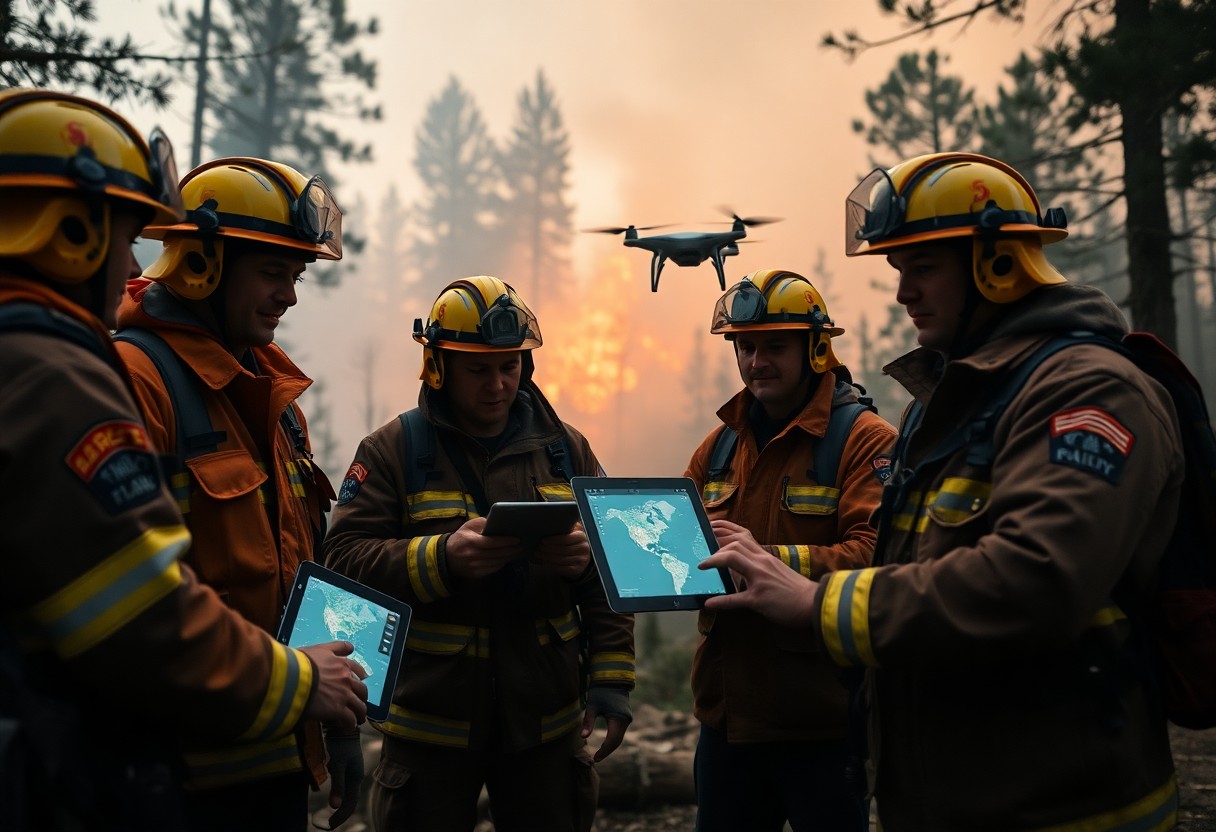Technology has transformed how volunteer fire departments approach wildland fire management, enhancing their ability to respond quickly and efficiently. By utilizing advanced tools such as drones, mobile applications, and GIS mapping software, you can gain critical situational awareness that improves decision-making during emergencies. These innovations not only streamline communication among teams but also help in resource allocation and risk assessment, ultimately ensuring that your community remains safer in the face of wildfires. In this post, we’ll explore how these technologies are shaping the future of volunteer fire departments and your role in this evolution.
The Role of Technology in Wildland Fire Management
To enhance the effectiveness of wildland fire management, technology plays an vital role in streamlining operations, improving communication, and aiding decision-making processes. By integrating advanced tools, volunteer fire departments can better predict fire behavior, coordinate responses, and allocate resources efficiently. This synergy of technology and traditional firefighting techniques helps ensure the safety of both firefighters and the communities they protect.
Communication Systems
Management of wildland fires significantly relies on effective communication systems that keep volunteers and agencies connected during emergencies. Modern technologies, such as radios, satellite phones, and mobile apps, facilitate real-time communication, ensuring that everyone is updated on firefighting strategies, resource needs, and changing conditions. The ability to transmit critical information quickly can lead to more efficient responses and ultimately save lives.
Data Collection and Analysis
Before tackling a wildland fire, the collection and analysis of data are vital for informed decision-making. Understanding the terrain, weather conditions, and previous fire patterns allows volunteer fire departments to plan effective strategies and allocate resources effectively.
In fact, utilizing remote sensing technology, drones, and geographic information systems (GIS) enables you to gather data from multiple sources. This real-time analysis allows for accurate mapping of fire fronts and identification of strategic locations for deployment. By harnessing this data, you can make informed choices and adapt to rapidly changing fire conditions to protect your community and fellow firefighters effectively.
Geographic Information Systems (GIS)
You can enhance your wildland fire management efforts through the use of Geographic Information Systems (GIS). This technology allows fire departments to analyze spatial data, enabling better-informed decision-making regarding fire behavior, terrain, and resource allocation. By incorporating GIS into their operations, volunteer fire departments gain access to valuable mapping tools and data visualization techniques that can significantly improve their response strategies and overall efficiency.
Mapping and Planning
Besides offering detailed visualizations, GIS plays an important role in effective mapping and planning for wildland fire management. It enables you to create comprehensive maps that outline critical features such as firebreaks, access routes, and water sources. These detailed maps assist in strategic planning and facilitate collaborative efforts among various emergency services and agencies.
Real-Time Tracking and Updates
Mapping technologies also extend to real-time tracking and updates, allowing you to stay informed about developing situations during fire incidents. This aspect of GIS helps you monitor fire spread, shifting weather patterns, and resource deployment efficiently.
Tracking your resources in real-time can significantly improve your operational response to wildland fires. By utilizing GIS-enabled tools, you can receive and process instantaneous data about your personnel and equipment locations, allowing for swift adjustments to evolving fire conditions. This capability not only enhances safety for responders but also improves coordination among various teams involved in fire management efforts, ensuring that resources are allocated optimally based on the current situation on the ground.
Drones and Aerial Surveillance
Some volunteer fire departments are increasingly adopting drones for aerial surveillance in wildland fire management. These unmanned aerial vehicles provide real-time data and imagery, allowing you to assess fire conditions from a bird’s-eye view. This capability enhances situational awareness, helping you make informed decisions during an emergency response, ensuring effective allocation of resources.
Fire Assessment and Monitoring
Fire assessment and monitoring are integral to managing wildland fires. You can utilize drones equipped with thermal imaging to detect hotspots and assess fire spread, enabling you to identify areas at risk quickly. This technology enhances your ability to prioritize firefighting efforts efficiently, ultimately improving safety for both personnel and the surrounding environment.
Search and Rescue Operations
Surveillance capabilities offered by drones also play a significant role in search and rescue operations. You can deploy drones to survey large areas that may be difficult or dangerous to access on foot, allowing you to locate missing individuals quickly and efficiently.
A drone’s ability to cover vast expanses of rugged terrain can be a game-changer during emergencies. You can use drones to transmit live feeds of the searched areas, helping to coordinate rescue efforts and direct ground crews more effectively. The integration of this technology not only saves time but enhances overall safety by reducing the risk to your team while operating in hazardous conditions.
Mobile Applications in Fire Response
Once again, technology proves to be an invaluable resource for volunteer fire departments in wildland fire management, particularly through mobile applications. These apps facilitate real-time communication, provide critical information on fire locations, and offer weather updates that help you make informed decisions in the field. By leveraging these tools, you can enhance your operational effectiveness and responsiveness during emergencies, ensuring better outcomes for both firefighters and the communities they serve.
Operational Coordination
The integration of mobile applications helps enhance operational coordination among your firefighting teams. These tools streamline communication, enabling timely updates and collaborative decision-making in the heat of the moment. With features such as GPS tracking, you can monitor team locations and resource allocation, ensuring that every member is effectively deployed and equipped to tackle wildland fires.
Training and Community Engagement
For volunteer fire departments, mobile applications also play a vital role in training and community engagement, enhancing your effectiveness as a first responder. These platforms offer access to training modules and resources, allowing you to continuously improve your skills and stay informed about best practices in fire management. Engaging with your local community through these apps encourages greater awareness and preparedness, fostering a safer environment.
Applications designed for training and community engagement allow you to connect with residents and provide them valuable fire safety information. You can share updates on training sessions, virtual workshops, and community events through these platforms. By fostering an active relationship with your community, not only do you enhance fire awareness, but you also promote volunteer opportunities, attracting new members to your team. Ultimately, these applications can cultivate a culture of preparedness, ensuring that your community is better equipped to face wildland fire threats.
Challenges and Limitations of Technology
Despite the advancements technology brings to wildland fire management, there are significant challenges and limitations that volunteer fire departments face. The effectiveness of technology can be hindered by issues such as unreliable internet connections, insufficient training, and varying levels of technical expertise among team members. Understanding these obstacles can help you better prepare your department for successful technology integration.
Technical Barriers
After implementing new technology, you may encounter technical barriers that impede its effectiveness. These might include outdated equipment, compatibility issues with existing systems, and the learning curve associated with new software or devices. Analyzing these challenges allows you to identify potential solutions and improve overall functionality.
Resource Constraints
Beside technical barriers, resource constraints can limit your ability to fully leverage technology in wildland fire management. Budget limitations, inadequate staffing, and the need for ongoing training can all create significant hurdles in implementing new systems and tools.
Even when you attempt to invest in technology, tight budgets can restrict access to important tools and resources. It might be challenging to prioritize technology upgrades when your focus is on basic operational needs. Moreover, you may find it difficult to allocate time for training, as volunteers often juggle their fire department duties with personal and professional responsibilities. Ultimately, addressing these resource constraints is vital for enhancing technology use in wildland fire management.
Future Trends in Fire Management Technology
All fire departments are increasingly turning to advanced technologies to enhance their wildland fire management strategies. From remote sensing tools to sophisticated communication systems, these innovations are transforming how you approach fire response and prevention. As new technologies evolve, they promise to provide more accurate data, improve situational awareness, and streamline operations, ultimately leading to more effective firefighting practices.
Emerging Tools and Innovations
One of the most exciting developments in fire management technology is the advent of new tools designed specifically for wildland firefighting. You can expect to see the use of drones equipped with thermal imaging, enabling real-time monitoring of fire fronts and inaccessible areas, enhancing your operational capability during emergencies.
Integration of AI and Big Data
The integration of AI and big data analytics is revolutionizing how fire departments predict, manage, and respond to wildfires. You can leverage these technologies to process vast amounts of data quickly, improving your decision-making process and allowing for more proactive measures in fire prevention.
Hence, embracing AI and big data can offer predictive modeling capabilities, identifying potential fire risks before they escalate. You can analyze historical fire behavior, weather patterns, and vegetation types to create more sophisticated risk assessments. This holistic view enables you to allocate resources effectively, optimize response strategies, and enhance collaboration with other agencies to safeguard your communities against wildfires.
Conclusion
From above, you can see how volunteer fire departments integrate technology into wildland fire management to enhance their efficiency and effectiveness. By utilizing advanced tools such as drones, mobile applications, and real-time data analysis, you can significantly improve communication and resource allocation during emergencies. Embracing these technologies not only enhances your safety but also strengthens your community’s resilience in facing the challenges posed by wildfires. As you continue to adapt to these innovations, your role in safeguarding lives and property becomes ever more impactful.

